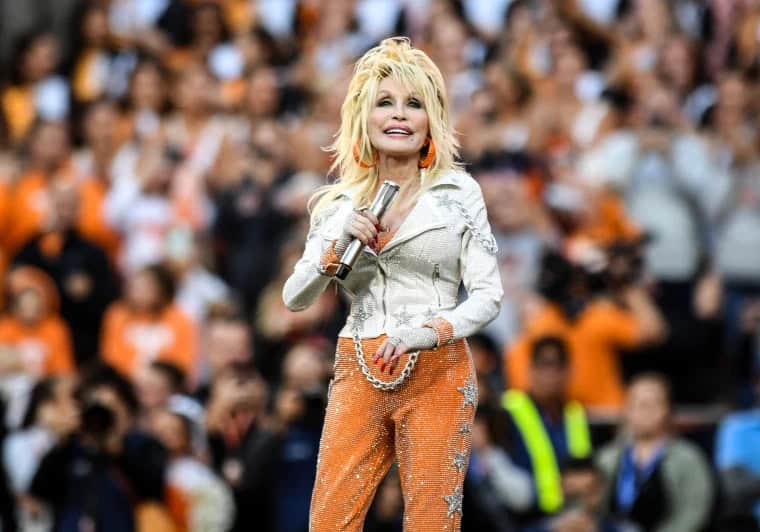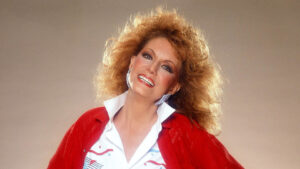Judy Eaton
Dolly Parton is one of those rare celebrities who is almost universally loved and respected. How can we explain this enduring popularity, from her early days as the “girl singer” on Porter Wagoner’s show to her more recent foray into Covid vaccines and rock and roll? Obviously there is no one thing that makes Dolly so special – in addition to being an accomplished musician, she’s a brilliant businesswoman, an actor, and a humanitarian. What could possibly be said about her that hasn’t already been said?
Despite her many accomplishments, Dolly has said that she is first and foremost a songwriter. With a career spanning almost six decades, and a release of almost one album per year, that’s a lot of songs. And to me – a lifelong Dolly fan and a social scientist – it’s also a pretty exciting dataset. My colleagues (fellow psychology researchers Danielle Law and Avnee Sharma at Wilfrid Laurier University) and I set out to find out if her songs, specifically her song lyrics, could give us any insight into her popularity.
Song lyrics are interesting because there’s what the artist says, and there’s also how they choose to say it. Take, for instance, two very similar songs: Deana Carter’s 1996 hit, Strawberry Wine and Lainey Wilson’s 2023 hit, Watermelon Moonshine. They both tell the story of nostalgia for a first love, but there are subtle differences in the words they use.
Strawberry Wine uses language such as “bittersweet,” “biggest fear,” “loss,” and “missing.” Watermelon Moonshine uses more positive language, such as “sweet buzz” and “laugh,” with no negatively focused words at all. They’re both sweet songs about young love, but the language used in Strawberry Wine makes it seem a bit more poignant.
In psychology we call this technique “narrative analysis” – analyzing the words that people use to learn about possible underlying meanings in what they are saying. In other words, we study the way people say things to try to understand what they might really mean.
Researchers have used this technique to study trends in popular music over time. When they quantified the use of “positive” words, like love, happy, and joy, in pop songs between the years of 1980 to 2007 they found a significant decline over time. Interestingly, pop music lyrics have decreased in positivity while depression rates have increased. The researchers suggest that this demonstrates how song lyrics can mirror our cultural experiences: as we become sadder as a nation, so do our songs.
Country music has also been found to have its finger on the pulse of the current cultural mood. During those times when social and economic conditions have taken a turn for the worse, country music lyrics have tended to be more upbeat and positive, and when the economy is strong, they tend to be less optimistic.
Back to Dolly.
What would we expect about the words she uses in her songs? We approached this question through the lens of positive psychology. Positive psychology is a branch of psychology that focuses on identifying and promoting the things that help people flourish. Rather than focusing on mental illness, it looks instead at what helps us stay well. It’s about resilience, optimism, gratitude, strengths, and positivity.
Dolly is literally the poster child for positivity – she’s on billboards promoting kindness through the “PassItOn” campaign – and her “dream more, learn more, care more, be more” message from her 2009 University of Tennessee commencement speech, later turned into her Dream More book, talks about how we can be better versions of ourselves while helping others as well.
Given that Dolly is kind of an honorary positive psychologist, we decided to investigate whether her song lyrics reflect her public persona of positivity and optimism. Our two main goals were to understand how Dolly uses positive language in her songs, especially compared to other popular music, and to find out whether this had changed over her five decades of writing music. Since she has had hits on both the country and pop charts, we included both as comparison groups.
At first glance, Parton’s song lyrics are a mixed bag. She has plenty of songs about love, but she also has what she calls her “sad ass” songs: tales of heartbreak, loss, suicide, mental illness, and social injustice. Rather than looking for positivity in the themes in her music, we looked at the words she used to describe these themes; in other words, our focus was not on what she said, but on how she said it.
For instance, think about how Dolly addresses the threat of losing her man to another woman in Jolene. Rather than criticize Jolene, she praises her (“your beauty is beyond compare…”). Now compare this to another well-known song with a similar theme from around the same time period: Loretta Lynn’s Fist City. Loretta’s approach is to choose violence over praise (“you better move your feet if you don’t wanna eat/a meal that’s called fist city”). This is not a criticism of Loretta’s approach – this song is truly epic – but it does rely on less positive language to deal with conflict.
In order to compare Dolly’s lyrics to both county and pop lyrics, our first task was to create a database of song lyrics. Dolly has more than 50 albums, but not all of those songs were written by her. We didn’t include those written by other people, and we also excluded the songs that she co-wrote with others, since the words in those songs wouldn’t be completely Dolly’s.
This left us with 247 songs written solely by Dolly Parton between 1967 (when her first album was released) and 2020 (the cutoff point of our research). For our comparison groups we used Billboard magazine’s top 10 songs for both country and pop, for each year from 1967 to 2020, removing any of Dolly’s songs that made the top 10 list. We collected and checked (with the help of some excellent research assistants – thanks Lauren, Gillian, and Samy!) the lyrics for all of these songs, giving us a total of 1321 songs.
We first compared the average percentage of positive language in Dolly’s songs compared to the averages in pop and country songs. As we predicted, and perhaps not surprisingly given her positive persona, Dolly’s songs contained the highest percentage of positive language of the three groups. That’s the pink bar below. Interestingly, the country songs (the dark blue bar) had the next highest percentage of positive language. Pop songs (the light blue bar) had the lowest. Country music may be known for its sad tales of lost loves, lost trucks, and lost dogs, but apparently it addresses them in a more positive way than pop music.
Dolly’s lyrics are significantly more positive than both pop and country, and country music uses significantly more positive language than pop music.
Next we looked whether the use of positive language has changed over time. For pop music, our results were the same as other researchers who have found decreases in positive language over time. It seems that, especially since the 1980s, the language used in pop music has become significantly less positive over the years. Country music has followed the same trend, with the use of positive language also dropping off beginning in the 1980s.
And then there’s Dolly.
Dolly’s songs have not wavered in their positivity since she released her first album in 1967. Unlike country and pop songs, which have become less positive over time, Dolly’s songs have always contained a high percentage of positive words, even when the songs themselves address sad themes. This isn’t to say that she hasn’t evolved as a songwriter or grown as an artist since the 1960s.
If anything, it suggests that despite her development as a songwriter, she has consistently addressed complex and challenging themes with language associated with positivity and optimism.
The positive language used in both pop and country songs took a dive after 1980. Dolly’s lyrics have remained consistently positive over the years.
If song lyrics are cultural products that can help us understand the current sociocultural environment, what does the timeless and consistent positivity in Dolly’s lyrics tell us? Relentless positivity will not land an artist on the Billboard charts these days, and as other genres of popular music get sadder and darker, Dolly’s lyrics are an anomaly. Her song lyrics clearly do not reflect the current mood, and yet she has arguably never been more famous.
Her fame, of course, is due to a combination of factors, including her personal charisma, her philanthropic endeavors, and her business acumen, in addition to her vast music catalogue and other creative pursuits, and it would be impossible to determine how much of her popularity is due to her celebrity and how much is due to her songs.
Here’s what we think our research findings can tell us about Dolly Parton.
Her positive lyrics, even in her “sad ass” songs, demonstrate how to face challenges with optimism and hope. Instead of tapping into how we are currently doing, maybe her lyrics are meant to serve more as a blueprint. Maybe Dolly’s songs aren’t a mirror to the current cultural mood; maybe they’re meant to be more aspirational than reflective. Maybe we need to ask ourselves more often “what would Dolly do?” Dolly would face hardship with a little more lightness and positivity, and maybe if we did that too we’d all be better off.
Here’s the source for the full article, in case you’d like to read more (or you can email jeaton@wlu.ca for a copy):
Eaton, J., Law, D., & Sharma, A. (2022). “I may look fake but I’m real where it counts”: Positivity and authenticity in the songs of Dolly Parton. Psychology of Aesthetics, Creativity, and the Arts. Advance online publication. https://doi.org/10.1037/aca0000527





